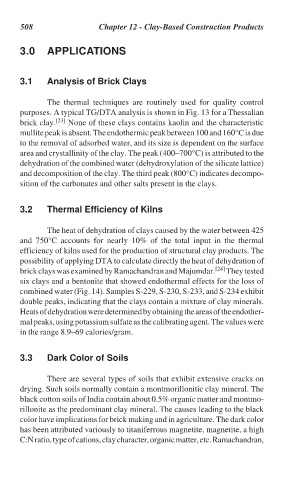Page 537 - Handbook of Thermal Analysis of Construction Materials
P. 537
508 Chapter 12 - Clay-Based Construction Products
3.0 APPLICATIONS
3.1 Analysis of Brick Clays
The thermal techniques are routinely used for quality control
purposes. A typical TG/DTA analysis is shown in Fig. 13 for a Thessalian
brick clay. [23] None of these clays contains kaolin and the characteristic
mullite peak is absent. The endothermic peak between 100 and 160°C is due
to the removal of adsorbed water, and its size is dependent on the surface
area and crystallinity of the clay. The peak (400–700°C) is attributed to the
dehydration of the combined water (dehydroxylation of the silicate lattice)
and decomposition of the clay. The third peak (800°C) indicates decompo-
sition of the carbonates and other salts present in the clays.
3.2 Thermal Efficiency of Kilns
The heat of dehydration of clays caused by the water between 425
and 750°C accounts for nearly 10% of the total input in the thermal
efficiency of kilns used for the production of structural clay products. The
possibility of applying DTA to calculate directly the heat of dehydration of
brick clays was examined by Ramachandran and Majumdar. [24] They tested
six clays and a bentonite that showed endothermal effects for the loss of
combined water (Fig. 14). Samples S-229, S-230, S-233, and S-234 exhibit
double peaks, indicating that the clays contain a mixture of clay minerals.
Heats of dehydration were determined by obtaining the areas of the endother-
mal peaks, using potassium sulfate as the calibrating agent. The values were
in the range 8.9–69 calories/gram.
3.3 Dark Color of Soils
There are several types of soils that exhibit extensive cracks on
drying. Such soils normally contain a montmorillonitic clay mineral. The
black cotton soils of India contain about 0.5% organic matter and montmo-
rillonite as the predominant clay mineral. The causes leading to the black
color have implications for brick making and in agriculture. The dark color
has been attributed variously to titaniferrous magnetite, magnetite, a high
C:N ratio, type of cations, clay character, organic matter, etc. Ramachandran,

